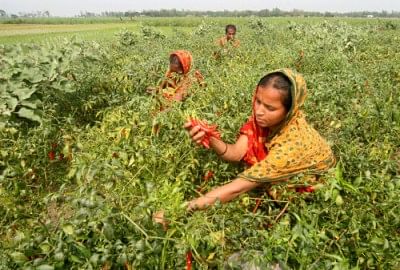Contribution of rural women

Photo: Shafiq Islam/ Drik News
Today is "World Rural Women's Day." The day is being observed to highlight the role played by rural women in food production and food security. For the first time, international NGOs at the Fourth World Conference on Women in Beijing in 1995 came up with the idea of honouring rural women with a special day. It was suggested that October 15 would be celebrated as World Rural Women's Day. The first International Day of Rural Women was observed in New York on October 15, 2008.
World Rural Women's Day was established by the General Assembly in its Resolution 62/136 of December 18, 2007. The resolution recognises "the critical role and contribution of rural women, including indigenous women, in enhancing agricultural and rural development, improving food security and eradicating rural poverty."
At the 10th session of the Regional Conference on Women in Latin America and the Caribbean in 2007, member states of the Economic Commission for Latin America and the Caribbean expressed their decision in the Quito Consensus to promote the adoption of an International Day of Rural Women. Their decision of honouring rural women was enlisted "as an explicit recognition of [rural women's] economic contribution and the development of their communities, in particular with regard to the unpaid work they perform."
The work and economic and social contributions of rural women can be grouped in two broad categories, imbedded in the community and embedded within the household. In a community, the economic production base determines the work or labour of rural women in the various segments of production. Rural women actively contribute to community production in most countries, thus improving social linkages and kinship relationships and facilitating resource exchange in times of need.
In the household, the traditional gender role ideology, founded on culture and religious tenets, determines the participation of rural women in household production. Contributions made by women within the household are increasingly affected by changes external to the household. For instance, rural poverty has acted as a push factor whereas new economic opportunities outside the household have emerged as pull factors encouraging rural women to cross customary gender role boundaries and to participate in the economy outside the household, often in farm production and sometimes in off-farm production.
Poor educational attainment, inadequate training and social immobility often prevent them from responding to these opportunities. Working at home (family care) is always seen as regular work of women without proper recognition of their labour. The women are primary care givers and domestic workers within the household at every stage of the life cycle, and this responsibility of care-giving is expanded to serve the needs of the community too.
In general, the work patterns of rural women are marked by change and continuity as well as flexibility and rigidity (Gurung, 1999). Change and flexibility in the role of rural women in farm production, off-farm production and community production are only to ensure the family's access to food and household resources. However, continuity and rigidity of social norms dictate that rural women and girls should assume home production responsibilities in rural households. The intra-household decisions on allocation of labour are often biased against rural women and girls.
Due to increasing economic pressures, gender roles are becoming flexible to enable women to engage in work traditionally regarded as belonging in the male domain. Traditionally, rural women in Bangladesh have played an important role in a wide range of income-generating activities, which include post-harvesting, cow fattening and milking, goat farming, backyard poultry rearing, pisciculture, agriculture, horticulture, food processing, cane and bamboo works, silk reeling, handloom weaving, garment making, fishnet making, coir production and handicrafts.
Social norms and traditions are changing due to extreme poverty and food crisis, and women are appearing in the field as well (Shirin, 1995). About 60-70% of women from landless and near-landless households now work as agricultural wage labourers, and earthwork and field-based workers, activities that traditionally have fallen within the male domain (Jahan, 1990).
Despite their routine domestic work, rural women in Bangladesh play an active role in ensuring household food security. They are in general responsible for most of the agricultural work in the homestead. They not only ensure protein supply of the family through rearing livestock and catching fish but also contribute to the household diet by growing various vegetables and fruits in the homestead garden. Farm activities in the homesteads, ranging from selection of seed to harvesting and storing of crops, are predominantly managed by women.
Female earning is increasingly becoming vital to the rural households, especially the poor households. It is found that 25% of landless households in rural Bangladesh are female headed and completely depended on female earnings (Safilios-Rothschild and Mahmud, 1989). Earnings of female members of a rural family contribute 25-50% of household income in 25% of the total male headed households (World Bank, 1990). Rural families are becoming economically dependent on the earnings of female members.
With the change of time and social dimension, rural women can no longer be identified as the "victim," rather they must be considered as the "manager" of the household for food security. Rural women always adopt diverse and intense household resource-use strategies to cope with food deficit situations, such as during the lean season and natural disasters, when they intensify their efforts in homestead production and seek non-farm production options.

 For all latest news, follow The Daily Star's Google News channel.
For all latest news, follow The Daily Star's Google News channel. 



Comments